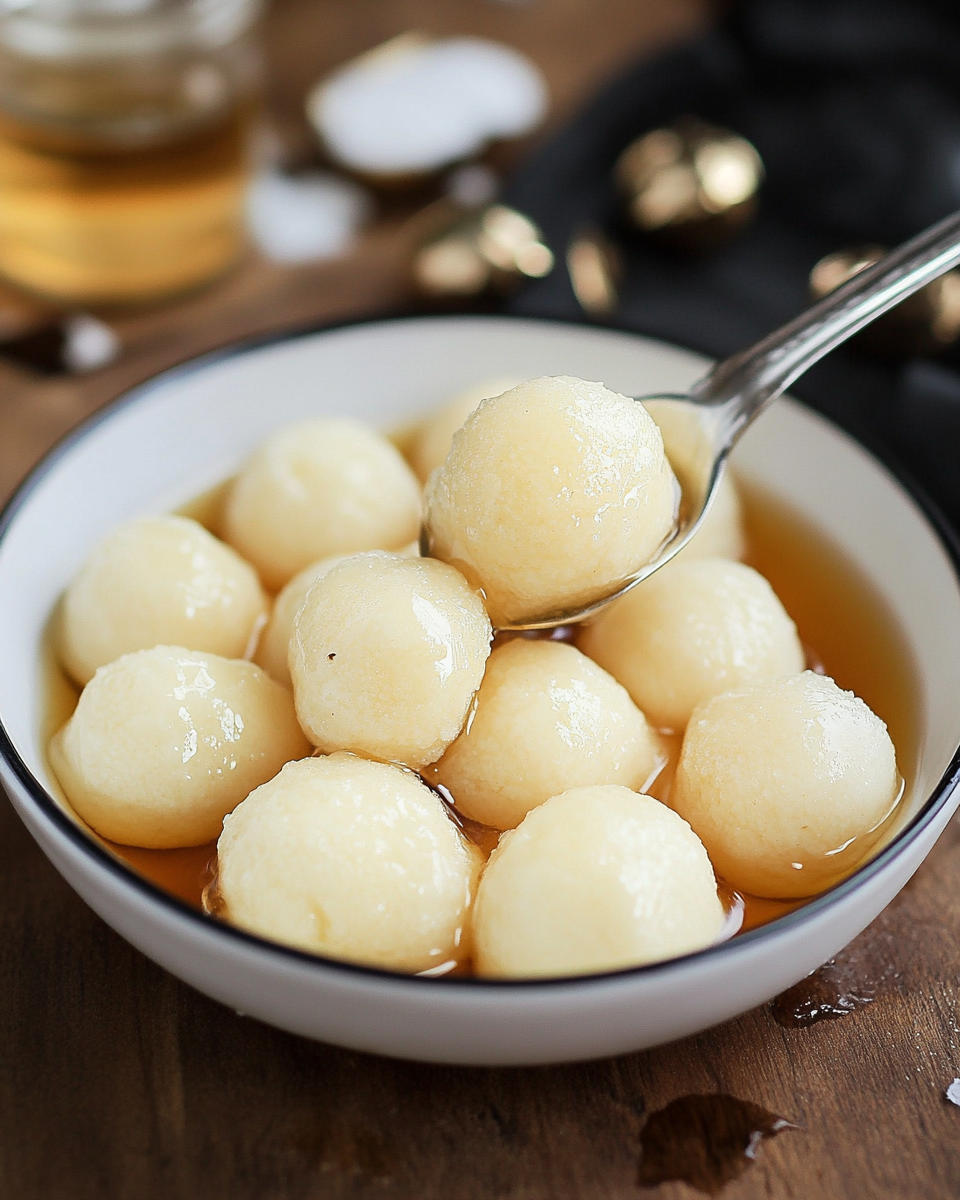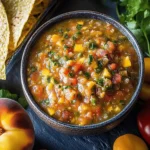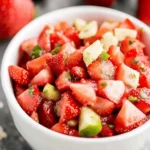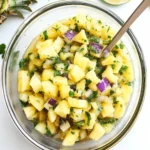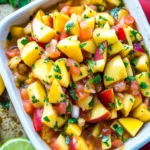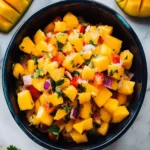A beloved Indian sweet, Soft Syrupy Rasgulla Bites are pillowy, spongy cheese balls soaked in fragrant sugar syrup. This miniature version of the classic dessert delivers all the melt-in-the-mouth goodness in bite-sized portions, perfect for parties or festive indulgence. Simple to prepare with just a few ingredients, these rasgullas are light, airy, and soaked to perfection.
FULL RECIPE
Ingredients
- 1 liter full-fat milk
- 2 tablespoons lemon juice (mixed with 2 tablespoons water)
- 1 cup sugar
- 4 cups water
- 1 teaspoon rose water or cardamom essence (optional)
- Ice cubes or cold water (for washing paneer)
Directions
- Boil milk in a heavy-bottomed pan over medium heat. Stir occasionally to prevent burning.
- Once it reaches a boil, lower the heat and gradually add lemon juice mixture, stirring gently until the milk curdles.
- Remove from heat as soon as curds separate from whey. Strain through a muslin cloth or fine strainer.
- Rinse the paneer under cold water to remove lemon flavor. Squeeze out excess water and hang the cloth for 30 minutes to drain.
- Knead the paneer on a flat surface for 8–10 minutes until smooth and pliable.
- Divide the dough into 15–18 small bite-sized balls, rolling gently without cracks.
- In a wide pan, combine sugar and water. Bring to a rolling boil.
- Add the paneer balls gently to the boiling syrup. Cover with a lid and cook for 12–15 minutes on medium-high heat. The rasgullas should double in size.
- Turn off the heat, let it rest covered for 10 minutes, then add rose water or cardamom essence.
- Chill before serving. Serve with syrup in a bowl or skewer as party bites.
Nutritional Information
- Calories: 150 kcal
- Protein: 5g
- Carbohydrates: 25g
- Fat: 4g
- Sugar: 20g
- Calcium: 150mg
Origin of Rasgulla
Rasgulla, also known as rosogolla in Bengali, is a quintessential dessert from the eastern part of India, particularly West Bengal and Odisha. While the debate over its true origin continues between the two states, its popularity has spread across India and beyond. The sweet was traditionally made during festivals and religious ceremonies and has since become a staple in Indian sweets shops.
Texture and Flavor Profile
Soft Syrupy Rasgulla Bites are known for their airy, spongy texture and subtle sweetness. The paneer base gives them a delicate, melt-in-the-mouth consistency. Once soaked in sugar syrup, the rasgullas become juicier, absorbing the flavor of the syrup, which can be infused with rose water, cardamom, or saffron for added depth.
What Makes Them ‘Bites’
Unlike the regular-sized rasgullas, this recipe focuses on miniature, bite-sized versions. These smaller portions make them perfect for parties, buffets, or festivals where guests may want to sample a variety of desserts. The bite-sized format also offers portion control and aesthetic appeal.
Paneer Quality and Preparation
The softness of rasgulla heavily depends on the quality of the homemade paneer (chhena). It must be fresh, well-drained, and kneaded thoroughly to break down granules. The kneading process is essential to ensure smoothness and elasticity, which helps in forming crack-free, smooth balls that cook evenly in syrup.
The Importance of Syrup Consistency
Sugar syrup plays a crucial role in flavor and texture. For Soft Syrupy Rasgulla Bites, the syrup must be thin, not thick like other Indian sweets. A thin syrup allows the rasgullas to absorb moisture and flavor without becoming overly sweet or sticky. Keeping the syrup boiling during the addition and cooking of rasgullas ensures even puffing and cooking.
Infusion Options
The syrup can be enhanced with aromatic additions like rose water, kewra essence, cardamom, or saffron. These not only add complexity to the flavor but also complement the subtle dairy notes of the rasgulla. Rose water gives it a floral fragrance, while cardamom brings warmth and spice.
Cooking Techniques
Cooking rasgulla requires gentle handling. The syrup must be at a rolling boil when the balls are added. A wide pan is preferred to give enough space for expansion. Covering the pan while boiling ensures even cooking and puffing of the paneer balls. It’s crucial not to overcrowd the pan.
Cooling and Soaking Time
Once cooked, rasgullas should be left in the syrup to cool gradually. This allows them to absorb more liquid and become juicier. Refrigeration further enhances their texture, making them denser yet softer as they settle in the syrup. Serving them chilled is highly recommended.
Serving Suggestions
Soft Syrupy Rasgulla Bites can be served in individual dessert cups or skewered on toothpicks for events. They pair well with other Indian sweets like gulab jamun or sandesh. Garnishing with slivered pistachios or saffron strands can elevate the presentation for special occasions.
Festive and Cultural Significance
Rasgullas are widely associated with Indian festivals such as Diwali, Durga Puja, and Raksha Bandhan. They symbolize joy, celebration, and hospitality. Making rasgulla at home during these occasions is a tradition in many households, passing down culinary skills through generations.
Variations Across Regions
In Bengal, the rasgullas are pure white and often softer due to lighter kneading. In Odisha, they might include semolina in the dough for added firmness. Some modern versions include stuffed rasgullas or chocolate-dipped bites. This recipe maintains the classic style while offering versatility through flavor infusions.
Modern Twists
Contemporary chefs have introduced flavors like saffron-almond, mango-infused syrup, and even fusion styles like rasgulla cheesecake. The miniature format allows more experimentation with fillings, colors, and presentation, especially in gourmet settings or food festivals.
Storage and Shelf Life
Homemade rasgullas can be stored in the refrigerator for up to a week in their syrup. They should be kept in an airtight container to prevent them from drying out or absorbing fridge odors. They are not freezer-friendly as the texture may degrade upon thawing.
Common Mistakes to Avoid
Over-kneading or under-kneading the paneer can affect texture. Similarly, using thick syrup or boiling the rasgullas on low flame may result in dense, rubbery balls. It’s important to follow the cooking time strictly and ensure the syrup stays at a constant boil during the process.
Nutritional Benefits and Cautions
Though a dessert, rasgullas are relatively light compared to fried sweets. They are a source of calcium and protein from the paneer. However, the sugar content is high, so moderation is advised, especially for those with dietary restrictions or diabetes.
Kids’ Favorite Dessert
Children love rasgulla due to its soft, bouncy texture and sweet taste. The bite-sized format is perfect for their little hands. It’s also a safer sweet for kids as it contains no nuts or hard ingredients, making it easy to chew and swallow.
Ideal for Make-Ahead Desserts
This recipe is ideal for preparing in advance. Making rasgullas a day before an event allows the flavors to develop fully. In fact, they taste even better the next day as they continue to absorb the syrup and firm up in the refrigerator.
Advertisement
Pairing With Beverages
Soft Syrupy Rasgulla Bites can be paired with light Indian beverages like masala chai or chilled rose milk. The subtle dairy-sugar combo of rasgulla balances well with aromatic and spiced drinks, creating a satisfying dessert experience.
Rasgulla in the Global Culinary Scene
Rasgulla has found its place in international desserts as well. From Indian fusion bakeries to Michelin-starred menus, chefs have adapted it into puddings, parfaits, and ice creams. The soft texture and mild flavor make it adaptable to various cuisines.
Conclusion
Soft Syrupy Rasgulla Bites are a delightful expression of India’s rich dessert heritage. Their light, spongy texture and syrupy goodness make them a universally loved treat. Whether served during festivals, family gatherings, or casual parties, these bite-sized delights bring joy and nostalgia to the table. Easy to prepare and highly customizable, they continue to evolve while maintaining their timeless charm.

